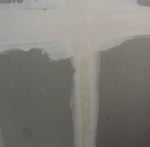
Tape the crack for added strength
Drywall cracks almost always occur where two sheets of drywall meet. When one or both of the sheets of drywall move, even slightly, a crack forms. Therefore, the first step in repairing drywall cracks is to eliminate the cause of movement. If you have not already done so, please read our article about determining and eliminating the cause of movement before continuing with the information below.
Drywall tape is used to provide added strength where two pieces of drywall meet. The tape is secured with drywall mud and serves to bind the two sheets of drywall together. It also creates a foundation for the finish mud.
To effectively repair drywall cracks it is important to first remove as much of the original drywall tape and mud as possible from the area. All loose pieces of tape should be peeled away. Drywall mud can be scraped from the surface using a six inch knife. When away excess mud, take care not to gouge the surface of the drywall. Only drywall mud and tape that comes off relatively easily should be removed.
The layer of tape that you will soon apply is only as good as the layer it will cover. In other words, if you apply a nice new layer of tape and mud over top of a piece of tape that is peeling off, the new layer will peel off along with the old layer. On the other hand, if the original tape is secure, the new layer of tape can safely be applied over the old.
Type of Drywall Tape for repairing cracks
There are different opinions as to what type of drywall tape to use when repairing cracks. Some will say that fiberglass mesh tape can be used to repair drywall cracks. However, we have found that paper tape makes for a slightly stronger joint. Since the goal of adding tape is to strengthen the joint, paper drywall tape should be used when repairing drywall cracks.
Type of Drywall Mud for repairing cracks
It is best to use all purpose drywall mud when using paper drywall tape. It provides a firm bond between the tape and drywall and is easy to work with. One downside to all-purpose drywall mud is that it takes many hours to dry before it can be re-coated. Since it is usually not practical to wait several hours before re-coating drywall repairs, quick set drywall mud can be used instead. Quick set drywall mud creates a firm bond and a strong surface finish. It does not shrink between coats which is an advantage when you are trying to add several coats within a short time.
How to tape drywall cracks
 Taping drywall cracks is basically the same as taping any drywall joint. Make sure to spread enough drywall mud behind the tape to create a firm bond. Be careful not to leave any pockets of air or bare spots behind the tape. This can pose more of a challenge when doing drywall repair than when working with new drywall since the surface usually has more imperfections.
Taping drywall cracks is basically the same as taping any drywall joint. Make sure to spread enough drywall mud behind the tape to create a firm bond. Be careful not to leave any pockets of air or bare spots behind the tape. This can pose more of a challenge when doing drywall repair than when working with new drywall since the surface usually has more imperfections.
After you have spread a base coat of mud and embedded the tape in the mud, spread it smooth with a six-inch knife to flatten and remove excess mud. Take care not to squeeze out too much mud from behind the tape since the mud is what serves as a binder. On the other hand, take care not to leave too much mud mounded behind or on top of the tape. It should be left smooth and even or slightly lower than the surrounding surface.
Once you have taped the drywall crack, it is ready to be finish-coated. Please read on to learn how to finish coat drywall cracks.
